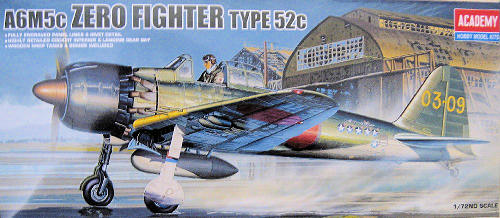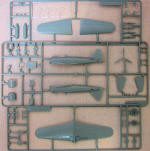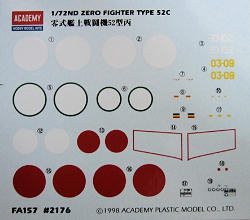
| KIT #: | 2176 |
| PRICE: | 10Ä |
| DECALS: | Two options |
| REVIEWER: | Dimitri J. Kremmydas |
| NOTES: | \ |

| HISTORY |
The Mitsubishi Zero was the iconic Japanese fighter of WWII. It fought from the beginning of the war (first combat trials took place in China) up until Japanís surrender. The development of the A6M5 was the result of the Imperial Japanese Navy having to deal with the new powerful, heavily armed and armoured fighters like the Hellcat and the Corsair. It included heavier armament, stiffer wing skin (to improve diving characteristics), individual exhaust stacks, and some cockpit armour and self-sealing fuel tanks to improve survivability. However, with most of its crack aircrew gone, and the IJN forced on the defensive, this was a case of too little too late. Still, over 10,000 were built. Of these, only 93 belonged to the Type 52c A6M5c Hei variant. The Academy kit represents one of them.
| THE KIT |
 I
normally do not build Japanese planes. Basically Iím a wuss when it comes to
masking canopies and few of them have the large bubble-type expanses of clear
glass found in P-47s, P-51s or Spitfires. However, impressed by Scottís review
of the Hasegawa Kate (let alone itís price) I picked one up during my last trip
to the local store. The Zero was more of an afterthought.
I
normally do not build Japanese planes. Basically Iím a wuss when it comes to
masking canopies and few of them have the large bubble-type expanses of clear
glass found in P-47s, P-51s or Spitfires. However, impressed by Scottís review
of the Hasegawa Kate (let alone itís price) I picked one up during my last trip
to the local store. The Zero was more of an afterthought.
The Academy kit comes in three gray and one clear plastic sprue, coming to a total of 58 parts (4 in clear plastic). The molding is crisp, with no flash apparent in my kit. However, ejector pin marks abound. Some will be invisible, although the ones on the cockpit floor, the inside of the gear doors, the main landing struts and wheels will be somewhat of a problem. Surface detail is good, being mostly recessed lines with some rivets here and there. None of it will look off scale after a coat or two of paint.
The Zero was not a complicated plane and the kit construction, detailed in 8 stages in the instructions is just as simple. The front office is composed of 6 parts and is pretty complete for the scale. There is even good sidewall detail on the fuselage halves. For most of us, a simple harness will suffice, although those so inclined will find several photo-etch and/or resin detail sets. The engine is also good for the scale. With the appropriate painting and weathering it will really look the part. One detail that I think is missing is the actuator rods for the cylinders. Stretched sprue can replace these, although I doubt much will be visible after the cowling and propeller are inserted. The 3-piece canopy can be posed open, and is thin enough so that this may be actually possible. The landing gear bays are a bit on the shallow side, but with plenty of structural detail. External stores include a wooden fuel tank (which according to the Zero In Action book is correct for the type) and four 30-kgr bombs.
 Markings are
for 2 A6M5c planes. One is the famous Hei flown by Takeo Tanimizu, the other
being from the 302nd Fighter Group in Atsugi. The kill markings in
Tanimizuís plane appear slightly off register, but Iíll live with it. Camouflage
is, not surprisingly, IJN Green over IJN Grey with yellow ID leading edges. It
should be noted that the interior color given in the instructions is definitely
not correct. Mitsubishi Interior Green was nothing like a metallic green. A look
into various builds in the MM archives will provide several possible shades that
are more authentic. However, the aotake of the landing gear bays could fade to a
metallic green over time. There is also no mention of the spinner or propeller
color, although the box art and pictures show them both in reddish brown. I have
no idea what the spinner of the other aircraft is like (its shown as grey in the
instructions). Academy decals are a mixed bag, so I canít tell how good these
will be. Still, with some Future and setting solutions, theyíll probably work
OK.
Markings are
for 2 A6M5c planes. One is the famous Hei flown by Takeo Tanimizu, the other
being from the 302nd Fighter Group in Atsugi. The kill markings in
Tanimizuís plane appear slightly off register, but Iíll live with it. Camouflage
is, not surprisingly, IJN Green over IJN Grey with yellow ID leading edges. It
should be noted that the interior color given in the instructions is definitely
not correct. Mitsubishi Interior Green was nothing like a metallic green. A look
into various builds in the MM archives will provide several possible shades that
are more authentic. However, the aotake of the landing gear bays could fade to a
metallic green over time. There is also no mention of the spinner or propeller
color, although the box art and pictures show them both in reddish brown. I have
no idea what the spinner of the other aircraft is like (its shown as grey in the
instructions). Academy decals are a mixed bag, so I canít tell how good these
will be. Still, with some Future and setting solutions, theyíll probably work
OK.
| CONCLUSIONS |
This is a great little kit. Itís cheap, very detailed for the scale and Academy kits are usually a joy to build. This looks like it will follow the trend. I donít know exactly how accurate it is (I can live with a millimeter or even two off here and there) but Iím pretty sure that it will look just like a late model Zero. For most of us this will be enough and thus this is a highly recommended kit.
August 2009
If you would like your product reviewed fairly and quickly, please contact me or see other details in the Note to Contributors.